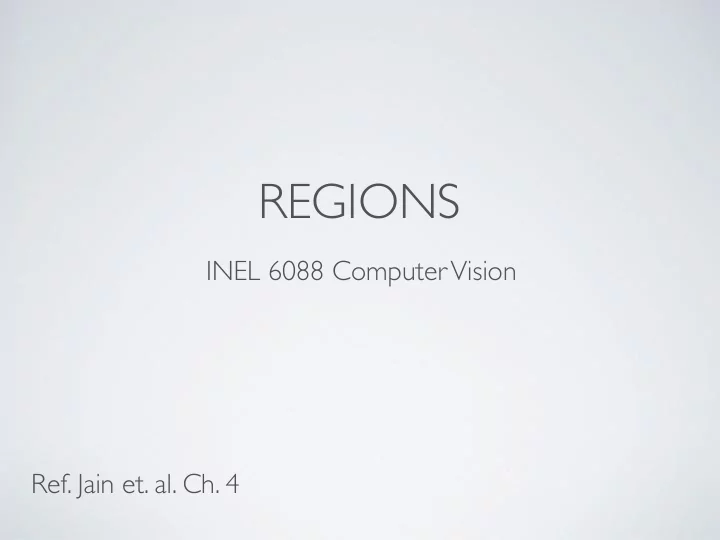

REGIONS INEL 6088 Computer Vision Ref. Jain et. al. Ch. 4
SEGMENTATION BY REGION SPLITTING AND MERGING
Segmented image RAG Dual of RAG
RAG MATLAB EXAMPLE Link to sample code
RAG MATLAB EXAMPLE Link to sample code distance function watershed
RAG MATLAB EXAMPLE Link to sample code
How do we judge if two regions are similar? • If the difference of their mean gray level is less than some predetermined value • If the regions are statistically similar. It is assumed that � H0: if the two regions belong to the same object, the intensities are drawn from a single Gaussian distribution with mean µ 0 and variance σ 02 � H1: if the two regions belong to different objects, they belong to two different Gaussian distributions with parameters (µ 1 , σ 12 ) and (µ 2 , σ 22 ).
Normal distribution Gray levels are represented by g i Normal distribution parameters: for n pixels
Assumption H0: if the two regions belong to the same object, the intensities are drawn from a single Gaussian distribution with mean µ 0 and variance σ 02 . If we assume H0, the joint probability density: Use previous definition to find σ using the m 1 +m 2 pixels.
Assumption H1: if the two regions belong to different objects, they belong to two different Gaussian distributions with parameters (µ 1 , σ 12 ) and (µ 2 , σ 22 ). To determine if the two regions should merge, find the likelihood ratio Merge if L is below some threshold.
MERGING BY REMOVING WEAK EDGES Combine regions if boundary between them is weak. • Pixel intensities in the two sides of a weak boundary differ by less than some amount T. • Boundary length must also be taken into account.
Merge regions R 1 and R 2 if : W = length of weak part of the boundary S = minimum of the perimeters of the two regions τ = threshold (0.5 is a good heuristic value) Do not merge merge
Another method: redefine S as the common boundary Do not merge merge Left: weak boundary is small compared to the total common boundary
REGION SPLITTING P n x ) 2 i =1 ( x i − ¯ Var = σ 2 = n
Possible ways of finding a boundary: • Use edge strength • Regular decomposition methods: divide region into a fixed number of equal-sized regions. • See quad-tree representation. Modify to use in grayscale images (see text) Region splitting is usually more dificult that merging.
P(R) = { 1 if the variance is small 0 otherwise
REGION GROWING
REGION GROWING
REGION GROWING
REGION GROWING
REGION GROWING Start with a set of “seed” regions, then expand the regions if they satisfy some constrain. Textbook example: homogeneity predicate is based on fitting a planar or biquadratic functions (m between 0 and 2, included) to the gray values: Homogeneity:
Algorithm 3.8: Region Growing Using Planar and Biquadratic Models (cont)
• Step 2 tries to avoid the effect of outliers – algorithm is very sensitive to outliers • One approach to find the seed regions is to use a conservative threshold • Another approach is to partition the image using domain knowledge
REGION REPRESENTATION Array representation • Labeled images - use an array of the same size as the original image to indicate the region to which each pixel belongs. • Overlays - use binary masks to define each region Other representations • Hierarchical representation – use many different resolutions to represent an image • Symbolic representation – enclosing rectangle, moments, Euler numbers • Boundary coding – use region boundaries
ARRAY REPRESENTATION (LABELING) (a) binary image (b) connected components
ARRAY REPRESENTATION (OVERLAYS)
HIERARCHICAL REPRESENTATIONS USING PYRAMIDS Contains the n × n image plus k reduced versions (levels). Fits into a linear array of size 2(2 2 × level ).
BINARY TREES • Emphasise inclusion of a region inside another region. • Constructed by recursively splitting an image into component parts. • Stops when regions have constant characteristics.
Quad Trees Representation • Obtained by recursively splitting of an image into 4 subregions. • If all points in a subregion are either black or white then that subregion is not further split and the subregion is marked as black or white. • Regions with both 0 & 1 are considered “gray” and can be further split. • Each node is either a leaf node or have four children. • Process is stopped when there are no further gray regions.
Recommend
More recommend